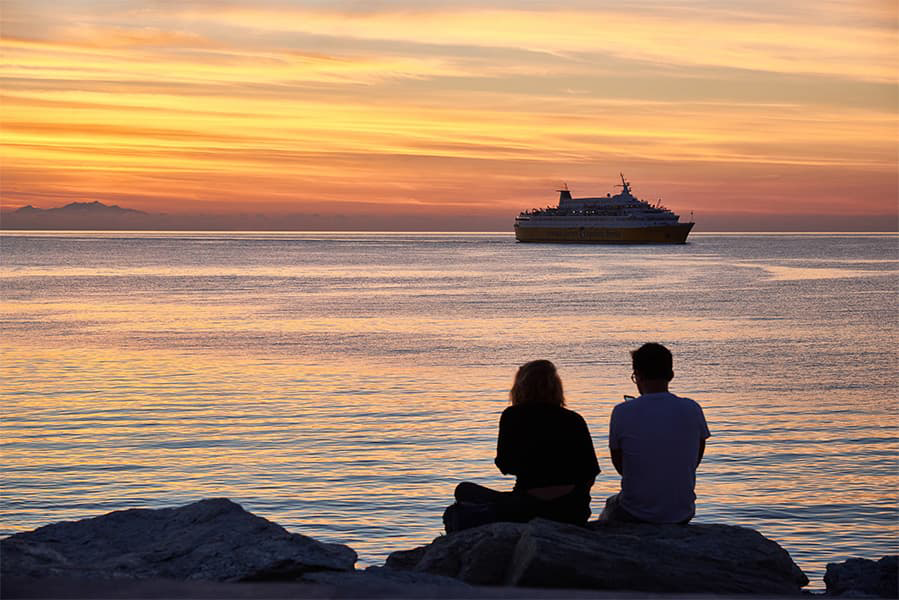Thessaloniki - Athens (Piraeus)
Ferries to Athens
Thessaloniki - Athens (Piraeus)
Ferries to Athens

provides the ferry from Thessaloniki to Athens (Piraeus). Thessaloniki Athens (Piraeus) ferries cost between 76€ and 1187€, depending on ticket details. Prices exclude any service fees. Ferry timetables change seasonally, use our Deal Finder to get live pricing and availability for Thessaloniki Athens (Piraeus) ferries.
Thessaloniki Athens (Piraeus) ferries typically depart at 21:30.
The Thessaloniki Athens (Piraeus) ferry trip can take around 27 hours 20 minutes. Sailing times can vary between ferry operators and can be impacted by weather conditions.
There is 1 weekly sailing from Thessaloniki to Athens (Piraeus) provided by .
Thessaloniki Athens (Piraeus) ferry prices typically range between 76€* and 1187€*. The average price is typically 100€*. The cheapest Thessaloniki Athens (Piraeus) ferry prices start from 76€*. The average price for a foot passenger is 80€*. The average price for a car is 1308€*.
Pricing will vary depending on number of passengers, vehicle type, route and sailing times. Pricing is taken from searches over last 30 days and exclusive of service fees, last updated 1 December 2025.
The distance between Thessaloniki to Athens (Piraeus) is approximately 177.4 miles (285.5km) or 154.2 nautical miles.
No, ferry operators currently do not allow cars to travel on sailings between Thessaloniki and Athens (Piraeus).
No, currently ferry operators do not allow foot passengers to sail between Thessaloniki and Athens (Piraeus).
Pets are currently not allowed on board the ferries from Thessaloniki to Athens (Piraeus).
More routes than anyone else.

Compare fares, times & routes in one place.
Change plans easily with flexi tickets.

Book e-tickets & manage trips in-app.
Live ship tracking & real-time updates.

Top-rated customer support when you need it.
The second largest city in Greece is Thessaloniki which is also the capital of the Macedonian region of the country. The city lies on the northern edge of the Thermaic Gulf and is bounded by Mount Chortiatis to the south east and the Gulf to its east. The city was founded by Cassander of Mecedon in 315 BC and went on to become an important city during Roman times when it became the second largest and richest city in the Byzantine Empire. The city was declared a UNESCO World Heritage Site in recognition of the many Byzantine monuments in the city which includes the Paleochristian and Byzantine monuments of Thessaloniki. Also in the city are a number of Roman, Ottoman and Sephardic Jewish monuments. Thessaloniki is regarded as the cultural capital of Greece and has many theatres and arts venues. The city's main theatres, run by the National Theatre of Northern Greece which was established in 1961, include the Theatre of the Society of Macedonian Studies, where the National Theatre is based, the Royal Theatre (Vasiliko Theatro), Moni Lazariston, and the Earth Theatre and Forest Theatre, both amphitheatrical open-air theatres overlooking the city.
Ferry services from the city's port depart to Varthi via Lemnos, Mitilini and Chios and then on to Kavala. Passenger facilities in the port include waiting rooms, cafes, information desks and public telephones.
The Greek city and port of Piraeus is one of the largest ports in the whole of the Mediterranean, and the third largest in the world, and has become a major hub for the ferry network that spans the Aegean Sea. Piraeus is an important city in its own right despite the fact that it is frequently considered to be a suburb of Athens, the Greek capital, which is only a very short distance away. Despite its proximity to Athens, Piraeus' waterfront has its own distinct appearance and visitors will see that the most appealing parts of the city are located around its eastern quarter, alongside both Mikrolimano Harbour and Zea Marina. A popular event in Piraeus is the Ecocinema International Film Festival which is held annually in late February and is where a number of films are screened at the Atticon Cinema and the Cineac Cinema, which are both located in the city's Town Hall Square.
Full of restaurants, bars and nightclubs, the waterfront district was greatly redeveloped in time for the Athens Olympics and as a result a new harbour front promenade was created that is lined with trees and passes the medieval city walls. The walls serve as a reminder and as an insight into the city's rich past.